Last week I met up with some folks from Friends of the Blue Hills (FBH) to help plan a cleanup day they've scheduled at Eliot Tower. Eliot Tower is an observation tower located at the top of Great Blue Hill in the Blue Hills Reservation in southeastern Massachusetts. It's at an elevation of about 635ft and affords an excellent view of the surroundings.
Since the Reservation is state-owned property, FBH needed to coordinate their cleanup efforts with the Massachusetts Department of Conservation and Recreation. Eliot Tower is a historic building so the Friends are fairly limited in what they can do to fix things up. One of the possibilities was the removal of invasive plants, and I was asked to assess the site for possible management opportunities.
I knew beforehand that two common invaders were there: black swallowwort (Cynanchum louiseae) and Asiatic bittersweet (Celastrus orbiculatus). Upon arriving at the Tower (okay, fine, upon catching my breath following a steep climb!) I did a quick survey of the area. The wall around the building was dotted with Asiatic bittersweet, black swallowwort, and a bunch of other native and introduced plants:
That seemed manageable! Adjacent to the tower were a few picnic tables, and next to that was more black swallowwort:
Those patches didn't seem that bad, and there was a nice population of native blue curls (Trichostema dichotomum) right nearby - it would be good to get rid of the invader there!
The Massachusetts Natural Heritage & Endangered Species Program classifies the area around Eliot Tower as Acidic Rocky Summit. There is no real canopy there, just a lot of exposed rock and some herbs, grasses and shrubby things where the soil is found. It's dry, too, as you can probably tell from the photos - the black swallowwort is looking pretty wilty. Around the margins of the rocky open area is a mixed oak/hickory forest, with some cherry trees along the very edge:
This still didn't look that bad, if the black swallowwort was just along the edge of the forest canopy. Then I turned to my right, and the true extent of the black swallowwort invasion began to take shape:
The vine has almost completely taken over the forest understory! It reaches back as far as the eye can see in the shot above. It also dominates the edges of the trail shown here:
I am not sure when black swallowwort first arrived on Great Blue Hill, but it looks like it is there to stay, for now anyway. I feel particularly bad for these two false Solomon's seal plants (Maianthemum racemosa), holding on for dear life in a sea of swallowwort (while the swallowwort holds on to them!):
It is sad to see this part of the Blue Hills Reservation lose so much of its character. Gone are most of the goldenrods, asters, and other native herbs, replaced by a monotonous view of a single, invasive species.
So what do you tell a group of volunteers eager to help clean up a site like this? A management plan to combat black swallowwort around Eliot Tower would need to go far beyond teams periodically hand-pulling the vines. For now, Friends of the Blue Hills will likely just focus their efforts on improving the physical aspects of the site (cleaning up trash and other tasks). While they could take this opportunity to do some outreach and remove the invasive plants from the perimeter of the building, but there is no practical way to prevent the black swallowwort from reinvading when it is so pervasive in the surrounding habitat. Prognosis: not good...unless you're black swallowwort.
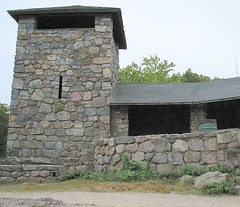
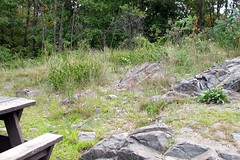
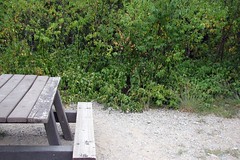
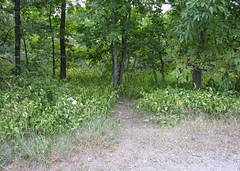
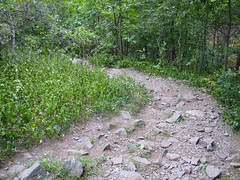

2 comments:
Hi.Congratulations. Great blog.I already linked your blog in my Dossier Biologia (Biology).
Pls welcome to my BioTerra- environmental education blog.
Beste wishes from Portugal.
good job! That swallowwart is a tricky little plant.. it's gotten to the point when I go for my jog/walk ('wog'?) through the local park, I carry a baggie and my folding shears.. the swallowwarts all going to pod/seed and MUST BE STOPPED!
makes me insane when I see it...
O_o
Post a Comment